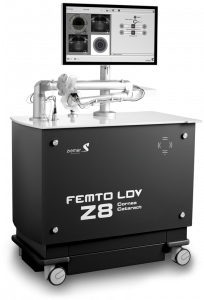In recent years, there has been much publicity about laser-assisted cataract surgery and significant debate as to whether it is superior to traditional cataract surgery.
A traditional cataract surgery procedure typically takes 10-12 minutes. In traditional cataract surgery, a blade is used make 2 micro-incisions in the cornea, which is the clear dome over the iris, in order to gain access to the cataract. A round opening, called a capsulorhexis, is made on the surface of the capsule, or bag, that surrounds the cataract using a small instrument. This opening is used to remove the cataract while preserving the capsule. The cataract is then broken up into small pieces and an ultrasound probe is then used to liquify these pieces and suck them out. Finally, an artificial lens is inserted into the capsule through the round opening.
Bladeless cataract surgery uses a laser instead of a blade to perform portions of the procedure. These include making small incisions in the cornea to access the cataract, creating the round opening on the front of the cataract, and breaking the lens into pieces. The same ultrasound probe used in traditional cataract surgery is then used to remove the lens pieces. At Milan Eye Center, our surgeons use the Ziemer FEMTO LDV Z8 laser. The femtosecond laser scans the entire eye through a water-filled layer, determining the exact thickness and location of the cataract and projecting a grid of precise coordinates for every single laser pulse that will be emitted during the procedure.
Contact Us For More Information
</scrip

Using a laser allows these steps to be performed more precisely and to the same specifications every time. It has been predicted that by making the opening (capsulorhexis) with a laser, it may improve a patient’s chances of not needing distance glasses after surgery due to the lens sitting in a more predictable location in the eye. Also, when the laser is used to “soften” the lens up prior to removal, it takes less ultrasound energy to remove the lens and this may result in less swelling of the eye and faster visual recovery. However, patients may have more inflammation after laser cataract surgery.
Furthermore, the accuracy of the Ziemer FEMTO LDV Z8 laser system also extends to astigmatism correction during a cataract surgery, allowing our ophthalmologists to create precise, customized incisions that are tailored to each patient’s unique eye anatomy.
At this time, clinical trials have not yet proven bladeless cataract surgery to be superior to manual or traditional cataract surgery. One study did show less corneal swelling and improved vision with the laser at 1 day and 1 week after surgery, but there was no difference in outcomes at 6 months. Most studies looking at the need for glasses after surgery have shown no difference in the percentage of patients dependent on glasses. Complication rates have been shown to be very low with both manual/traditional and bladeless/laser cataract surgery, although there have been slightly higher rates reported with laser surgery.
Patients that may have the greatest chance of improved outcomes with laser or bladeless cataract surgery include:
Insurance does not cover the cost of use of the laser, which is typically paid out of pocket by the patient. However, traditional cataract surgery would be covered.
Using a laser allows these steps to be performed more precisely and to the same specifications every time. It has been predicted that by making the capsulorhexis with a laser, it may improve patient’s chances of not needing distance glasses after surgery due to the lens sitting in a more predictable location in the eye.
Also, when the laser is used to “soften” the lens up prior to removal, it takes less ultrasound energy to remove the lens and this may result in less swelling of the eye and faster visual recovery. However, patients may have more inflammation after laser cataract surgery.
At this time, clinical trials have not yet proven laser cataract surgery to be superior to manual cataract surgery. One study did show less corneal swelling and improved vision with the laser at 1 day and 1 week after surgery, but there was no difference in outcomes at 6 months. Most studies looking at the need for glasses after surgery have shown no difference in the percentage of patients dependent on glasses. Complication rates have been shown to be very low with both manual and laser cataract surgery, although there have been slightly higher rates reported with laser surgery.
Patients that may have the greatest chance of improved outcomes with laser surgery include those with extremely dense cataracts that require a large amount of ultrasound energy for removal and patients with white cataracts which have elevated pressure inside of the capsule increasing the difficulty of creating the capsulorhexis.
Insurance does not cover the cost of use of the laser, which is typically paid out of pocket by the patient.
It is a testament to the great outcomes that are currently achieved with standard cataract surgery, that so far it has been difficult to prove that lasers are superior. More studies are needed to find the definitive answer to this question.
Our knowledgeable staff is here to answer all your questions about which procedure is best for you, and ensure you have the most comfortable experience possible. Make an appointment today at one of our eight convenient locations.
Schedule an Appointment Online
Or call 678-381-2020